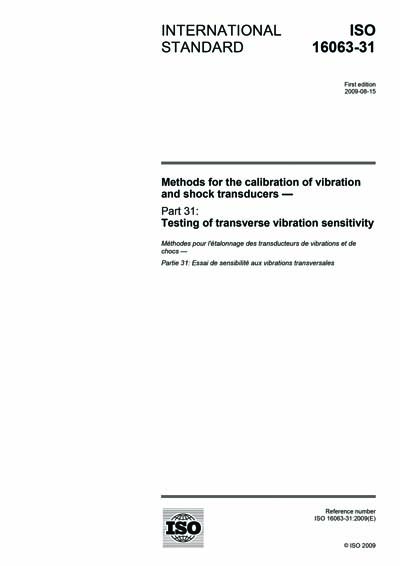Most recent
ISO 16063-31:2009
Methods for the calibration of vibration and shock transducers - Part 31: Testing of transverse vibration sensitivity
ISO 16063-31:2009 specifies details of the instrumentation and methods to be used for transverse vibration sensitivity testing. It applies to rectilinear velocity and acceleration transducers.
The methods and procedures specified in ISO 16063-31:2009 allow the determination of the sensitivity of a transducer to vibration in the plane perpendicular to its geometric axis of sensitivity. Because the magnitude of this transverse sensitivity can vary with the direction of the applied vibration, the various methods determine the maximum value. Using that value, the ratio of the transverse sensitivity to the sensitivity on the geometric axis of the transducer can be calculated. In addition, the angle at which the maximum transverse sensitivity occurs can be determined.
The methods and techniques specified can be applied without re-mounting the transducer away from its mounting surface during the test, thus avoiding significant uncertainties often encountered in methods which require repeated mounting. The different methods specified use a single-axis vibration exciter, a two-axis vibration exciter or a tri-axial vibration exciter. Tri-axial vibration excitation allows the transverse sensitivity and the sensitivity on the geometric axis to be determined simultaneously, thus simulating application conditions where the transducer is exposed to multi-axial vibration.
ISO 16063-31:2009 is applicable to a frequency range from 1 Hz to 5 kHz and for a dynamic range from 1 m/s2 to 1 000 m/s2 (frequency dependent) and from 1 mm/s to 1 m/s (frequency dependent). Although among all the systems specified it is possible to achieve these ranges, generally each has limitations permitting its use in much smaller ranges.
The methods specified are by comparison both to a reference transducer and to a laser interferometer.
The methods specified allow an expanded uncertainty of the transverse sensitivity (coverage factor k = 2) of 0,1 % or less to be achieved, if the expanded uncertainty is expressed as a percentage of the sensitivity of the test transducer in its sensitive axis.
Content Provider
International Organization for Standardization [iso]






